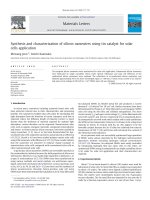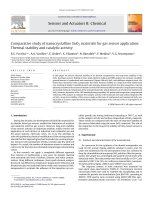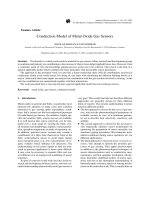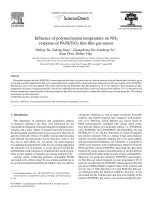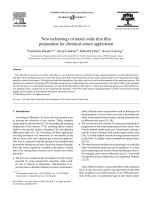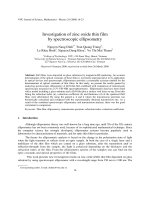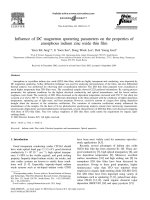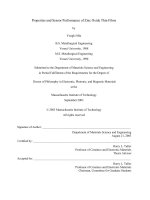- Trang chủ >>
- Khoa Học Tự Nhiên >>
- Vật lý
new technology of metal oxide thin film preparation for chemical sensor application
Bạn đang xem bản rút gọn của tài liệu. Xem và tải ngay bản đầy đủ của tài liệu tại đây (360.22 KB, 7 trang )
Sensors and Actuators B 109 (2005) 128–134
New technology of metal oxide thin film
preparation for chemical sensor application
Viacheslav Khatko
a,∗
, Josep Calderer
b
, Eduard Llobet
a
, Xavier Correig
a
a
Departament d’Enginyeria Electronica, Universitat Rovira i Virgili, Campus Sescelades, 43007 Tarragona, Spain
b
Departament d’Enginyeria Electronica, Universitat Politecnica de Catalunya, Campus Nord, 08034 Barcelona, Spain
Available online 3 May 2005
Abstract
The reduction of grain size in metal oxide films is one of the key factors to enhance the gas sensing properties of semiconductor layers.
The basic idea introduced here is to create thin metal oxide films with small grain size by using a special regime of rf sputtering from either
metallic or metaloxide targets. The regime includes the deposition of thin films with one or several interruptions of the sputtering process. The
idea has been checked by preparing WO
3
thin films using reactive rf sputtering from a pure tungsten target. Four types of films were prepared.
For the first type a non-interrupted sputtering was used. In the deposition of films type 2, 3 and 4, the sputtering process was interrupted once,
two and three times, respectively. It was found that the thickness of the WO
3
films and the sensing properties of WO
3
based sensors heavily
depend on the number of interruptions during the deposition process.
© 2005 Elsevier B.V. All rights reserved.
Keywords: WO
3
thin films; Deposition with interruptions; WO
3
-based sensors; Rf sputtering
1. Introduction
According to Morrison [1], there exist four general ways
to increase the selectivity of gas sensors. These comprise
usingcatalysts andpromoters[2–6], controllingtheoperating
temperature of the sensors [7–9], including special surface
additives for specific surface adsorption [10] and applying
differential filters [11–14]. Nowadays, all these approaches
are being developed very intensively. In our opinion, in the
last few years a new way to preparegas sensors has appeared.
This way is connected with the attempt to find methods that
increasethe surfacearea ofactivelayersfor chemicalsensing.
Since the sensor sensitivity is related to the surface–volume
ratio of its sensing film, research can be carried out in three
directions:
• The first one is related to the investigation of active layers
prepared by using nanopowder materials, where parti-
cle size is reduced to nanometers. Nanostructure is ex-
pectedto havea dramaticinfluenceon sensorperformance.
∗
Corresponding author. Tel.: +34 977558653; fax: +34 977559605.
E-mail address: (V. Khatko).
Many different nano-sized powders and technologies for
the preparation of active layers are used to investigate the
effect of the nanostructure on their sensing characteristics
to different toxic gases [15–18].
• The second direction consists of using special methods of
preparation for the surface patterning of active layers. One
of suchmethods impliesa processof anisotropic etchingto
provide a sensor substrate with a much higher surface area
[19]. A second method consists ofusing a porous structure
on the base of a highly ordered nanoporous alumina layer
[20,21].
• The third direction includes the technologies via with thin
films of nanometer grain size can be deposited. As a rule,
these technologies are used to obtain thin film gas sensors.
For example, active layers with grain size of 1–2nm could
be deposited using rf sputtering or dc magnetron methods
[22,23].
Oneofthe basicideastocreatemetalfilmswithsmall grain
size is to use successive step-by-step deposition of ultra-thin
films resulting in an island structure of two different mate-
rials. In this case, at a particular stage of pure metal cluster
0925-4005/$ – see front matter © 2005 Elsevier B.V. All rights reserved.
doi:10.1016/j.snb.2005.03.073
V. Khatko et al. / Sensors and Actuators B 109 (2005) 128–134 129
development, clusters of another material can be formed to
restrict the coalescence of the metal clusters and the forma-
tion of a continuous layer. This technology has been applied
with success inthe development of catalyticlayers for silicon
micromachined calorimetric gas sensors [22,23].
A second basic idea consists of using a special regime of
thin film deposition by dc magnetron, ion-beam or rf sputter-
ingfrommetallicor metaloxidetargets. Two differentspecial
regimes can be used. In the first one the formation of “extra”
interfaces in the body of the metal film occurs as a result of
the sputteringpowerdensity beingchanged duringfilmdepo-
sition. As a rule a low deposition rate is set during the initial
stage of film deposition and a high deposition rate is used
during the final stage of the deposition. The second regime
implies growing the film with one or several interruptions of
the deposition process. In this case the “extra” interfaces are
introduced into the body of the thin film. During the inter-
ruption of the sputtering process or when a sudden change in
the deposition rate occurs, an equilibrium surface is formed
due to the free surface bond saturation by the atoms from
residual atmosphere and/or the structural relaxation of the
interface. For the subsequent prolongation of the deposition
process, film growth begins over again on the new “extra”
equilibrium surface and the average grain size of the film at
the surface is smaller than in the original film. It has been
shown that this leads to metal films with a decreased average
grain size. The first regime has been used for the deposition
of Schottky barriers and MOS transistor gates [24,25]. The
use of this regime has allowed obtaining the enhancement of
catalytic properties of Pt-SiO
2
thin films, as well [26].
Among metal oxide semiconductors, tungsten oxide is
a promising material for gas sensing. Several studies have
shown that it can be used for the detection of nitrogen ox-
ide (NO and NO
2
), carbon monoxide, ammonia vapours, and
hydrocarbons. Tungsten oxide films can be deposited by re-
active rf sputtering, thermal evaporation and other methods.
The results obtained indicate that the characteristics of the
sensors heavily depend on the conditions and methods used
in their preparation[27–31]. Since grainsize is one ofthe key
factors to enhance the gas sensing properties of metal oxide
sensors, the aim of this paper is to study the influence of in-
terrupting the deposition process on the sensing properties of
WO
3
thin films prepared by rf sputtering.
2. Experimental
The tungsten oxide films were deposited on top of silicon
wafers by reactive rf magnetron sputtering using a ESM100
Edwards sputtering system. A metal target of 99.95% purity
with a diameter of 100 mm and thickness of 3.175mm was
used. The target to substrate distance was set at 70 mm. The
silicon wafers, oxidised in dry oxygen, were held in thermal
contact with a holder during the deposition process. The sub-
strate temperature was kept constant during film deposition
at room temperature. The sputtering atmosphere consisted of
Ar–O
2
mixed gas and its flow rate was controlled by separate
gas flowmeters to provide an Ar:O
2
flow ratio of 1:1. The
pressure in the deposition chamber during sputtering was
5 × 10
−3
mbar. The rf sputtering power was 200W. These
conditions of deposition gave an average deposition rate up
to 2.12 nm per min.
Four types of tungsten oxide films were prepared. For the
first type a non-interrupted sputtering was used. In the de-
position of films type 2, 3 and 4, the sputtering process was
interrupted once, two and three times, respectively. A shutter
was used to interrupt the deposition process. The total de-
position time was 40, 40.5, 41 and 41.5 min, for films type
1, 2, 3 and 4, respectively. The interruption time was set to
30 s. Film thickness was controlled by ellipsometry (PLAS-
MOS 2000) and stylus profilomentry (DEKTAK 3030) and
was calculated from AES profiles as well.
The samples used to investigate the gas sensing properties
ofthe filmsasafunction ofthenumberof interruptionsduring
the deposition process were based on silicon substrates. The
top contacts to the sensing layers were formed using air dry
silver paste (Heraeus AD1688-06). Using this paste the test
samples were fixed on the ceramic heater prepared according
to the method reported in [32].
Theresponse ofthedifferentfilmsto nitrogendioxide,car-
bon monoxide, ethanol and ammonia was investigated. The
sensors were kept in a temperature and moisture controlled
test chamber (27
◦
C, ±1
◦
C and 41–43% RH). The sensors
were operated at the temperaturerange from 150 to 300
◦
Cto
analyse the effect of working temperature on their response.
The resistance of the sensing layers in the presence of either
pure air (R
air
) or the different pollutants (R
gas
) at the different
concentrations was monitored and stored in a PC.
The morphology of the sensing layers was determined by
AFM. The sensing layer surface and the chemical element
distributions in the samples were examined with a PHI-660
Auger spectrometer operating at 3 kV and using a probe di-
ameter up to 1m. Auger electron collection depth was up
to 2.0 nm.
3. Results and discussion
3.1. Measurement of film thickness
Table 1 shows the measured thickness of the WO
3
thin
films. Two basic tendencies in the thickness as a function of
Table 1
Thickness (nm) ofthe WO
3
thin film asa function of thenumber of interrup-
tions of the deposition process as estimated by profilometry andellipsometry
Number of interruptions Measurement method
Profilometry Ellipsometry
0 83.2 ± 1.0 81.51 ± 0.11
1 80.0 ± 1.0 65.9 ± 0.61
2 74.0 ± 1.0 55.6 ± 0.33
3 69.5 ± 1.0 –
130 V. Khatko et al. / Sensors and Actuators B 109 (2005) 128–134
Fig. 1. AES profiles of rf sputtered WO
3
thin films without interruption (a), one (b) and two (c) interruptions of the deposition process.
V. Khatko et al. / Sensors and Actuators B 109 (2005) 128–134 131
the numberof interruptionsduringthe depositionprocess can
be derived from Table 1:
• Differences arisein thethickness measuredby profilomen-
try and ellipsometry forthose tungsten oxide thin films de-
posited with interruptions during the deposition process.
The formation into the body of the thin film of several
“extra” interfaces made difficult the measurement of film
thickness by ellipsometry. Particularly, the method could
not be applied to measure films deposited with three inter-
ruptions.
• The total thickness of WO
3
thin films decreases when the
number of interruptions during the deposition process in-
creases. Fig. 1 shows AUG depth profiles of chemical el-
ements into the WO
3
thin films. It can be seen decreasing
the film total thickness that is proportionate to total sputter
time.
3.2. Gas sensitivity studies
The responses of the different films to nitrogen dioxide,
carbon monoxide,ammonia and ethanolwere analysed atop-
erating temperatures 150, 200, 250 and 300
◦
C. Fig. 2 shows
Fig. 2. Sensor responseofrf sputtered WO
3
sensing layers toNO
2
at 150
◦
C
(a) and 200
◦
C (b). WO
3
(0), WO
3
(1) and WO
3
(3) are sensing layers
prepared without, with one and three interruptions of thedeposition process,
respectively.
Fig. 3. Sensor response of rf sputtered WO
3
sensing layers to ammonia at
250
◦
C. WO
3
(0), WO
3
(1) and WO
3
(3) are sensing layers prepared without,
with one and three interruptions of the deposition process, respectively.
the response of the different tungsten oxide thin films to NO
2
at 150
◦
C(Fig. 2a) and 200
◦
C(Fig. 2b). No matter the op-
erating temperature set, sensors based on tungsten trioxide
films prepared with the maximum number of interruptions
(i.e. three) during their growth show the highest sensitivity to
NO
2
. For example, at 1 ppm of NO
2
, the sensitivity for these
sensors calculated using the relation S=(R
gas
− R
air
)/R
air
is
2.156, 0.468, 0.255 and 0.167 at 150, 200, 250 and 300
◦
C,
respectively. None of the WO
3
sensing layers responded to
CO in the temperature range investigated.
The sensors responded to ammonia when operated be-
tween 200 and 300
◦
C. Fig. 3 shows the response of the dif-
ferent sensing layers to 10ppm of ammonia at the working
temperature of250
◦
C. Onceagain, the sensorsprepared with
three interruptions during the deposition process show the
highest sensitivity. Table 2 summarises the sensitivity results
to ammonia for the different films studied. It can be seen
that 250
◦
C is the optimal temperature for ammonia sensing
(sensitivity is higher at this operating temperature).
Fig. 4 shows the response of the different WO
3
sens-
ing layers to ethanol at the working temperatures of 250
◦
C
(Fig. 4a) and 300
◦
C(Fig. 4b). The sensors responded to
ethanol when operated between 200 and 300
◦
C. At 200 and
250
◦
C theyprepared withoutinterruptions duringtheir depo-
sition process show the highest sensitivities. However, when
operated at 300
◦
C, sensors prepared with three interruptions
during their deposition process show the highest sensitivity
Table 2
Sensor sensitivity (S) in the presence of 10 ppm of ammonia as a function
of the working temperature and number of interruptions of the deposition
process
Number of interruptions Working temperature (
◦
C)
200 250 300
00.501 0.527 0.0
10.19 0.372 0.209
30.616 1.189 0.22
132 V. Khatko et al. / Sensors and Actuators B 109 (2005) 128–134
Fig. 4. Sensor response of rf sputtered WO
3
sensing layers to ethanol at
250
◦
C (a) and 300
◦
C (b). WO
3
(0), WO
3
(1) and WO
3
(3) are sensing
layers prepared without, with one and three interruptions of the deposition
process, respectively.
to ethanol. Table 3 summarises the sensitivity to ethanol for
the different films and operating temperatures studied.
3.3. Morphology of the WO
3
films
The surface ofthe tungsten trioxide films was investigated
by AFM (Nanoscope III). Fig. 5 clearly points out the in-
fluence of the number of interruptions during the sputtering
process on the morphology of deposited metal oxide films. It
can be seen that increasing the number of interruptions leads
to a decrease in the roughness of the film surface.
Table 3
Sensor sensitivity (S) in the presence of 10 ppm of ethanol as a function
of the working temperature and number of interruptions of the deposition
process
Number of interruptions Working temperature (
◦
C)
200 250 300
00.103 0.463 0.332
10.00.303 0.384
30.00.437 0.449
Fig. 5. AFM surface morphology of WO
3
thin films without interruption
(a), one (b) and three (c) interruptions of the deposition process.
3.4. Discussion
As indicatedabove,thechanges inthe thickness ofthe dif-
ferent WO
3
films allow drawing the conclusion that “extra”
interfaces couldbe formed duringthe process ofinterruption.
The prolongation of film growth on the “extra” interface in-
volves anewnucleation ofthe metaloxidefilm, theformation
and growth of a film island structure and, finally, the forma-
tion of a continuous layer. All the steps in this process of
V. Khatko et al. / Sensors and Actuators B 109 (2005) 128–134 133
film growth take a specific time to complete. Therefore, the
total film thickness decreases by increasing the number of
interruptions during the deposition process. The analysis of
AUG depth profiles shows that the formation of “extra” in-
terfaces is not related to the free surface bond saturation by
the atoms from residual atmosphere. Obviously, the “extra”
interfaces are formed due to the surface relaxation during
the interruption time. This differs from the results obtained
for metal films deposited in an atmosphere containing oxy-
gen [33], where the sputtered films adsorb oxygen from the
residual atmosphere.
The enhancement of the sensing properties observed for
WO
3
films depositedwiththree interruptions isdue to thede-
creasein grainsizeintothemetaloxidefilms. Thisconclusion
is confirmed byAFM data. Certainly, further confirmationby
alternative methods would be necessary. Work is in progress
to perform more analyses, in particular transmission electron
microscopy, on the samples.
4. Conclusions
WO
3
thin films were deposited by reactive rf sputter-
ing from a pure tungsten target. The deposition process
was conducted without interruption and with one, two and
three interruptions. On the base of these films, sensing lay-
ers were prepared and their response to NO
2
, CO, ammonia
and ethanol was investigated. It was shown that the sensing
layers prepared with the maximum (i.e. three) number of in-
terruptions show the best sensing properties. The increase
in sensitivity is related to the decrease of grain size in the
WO
3
thin films observed as the number of interruptions was
increased. This conclusion is based on AFM data.
References
[1] S.R. Morrison, Selectivity in semiconductor gas sensors, Sens. Ac-
tuators 12 (1987) 425–440.
[2] G. Sberveglieri, S. Groppelli, P. Nell, V. Lantto, H. Torvela, P. Romp-
painen, S. Lepp
¨
avuori, Response to nitric oxide of thin and thick
SnO
2
films containing trivalent additives, Sens. Actuators, B Chem.
1 (1990) 79–82.
[3] J. Mizsei, V. Lantto, Simultaneous response of work function and
resistivity of some SnO
2
-based samples to H
2
and H
2
S, Sens. Ac-
tuators, B Chem 4 (1991) 163–168.
[4] K.D. Shierbaum, U. Weimar, W. Gopel, Comparison of ceramic,
thick-film and thin-film chemical sensors based upon SnO
2
, Sens.
Actuators, B Chem. 7 (1992) 709–716.
[5] E. Llobet, G. Molas, P. Molinas, J. Calderer, X. Vilanova, J. Brezmes,
J.E. Suegras, X. Correig, Fabrication of highly selective tungsten
oxide ammonia sensors, J. Electrochem. Soc. 147 (2000) 776–779.
[6] C. Bittencourt, R. Landers, E. Llobet, G. Molas, X. Correig, M.A.P.
Silvaa, J.E. Sueiras, J. Calderer, Effect of oxygen partial pressure
and annealing temperature on the formation of sputtered tungsten
oxide films, J. Electrochem. Soc. 149 (2002) H81–H86.
[7] R. Ionescu, E. Llobet, Wavelet transform-base fast feature extrac-
tion from temperature modulated semiconductor gas sensors, Sens.
Actuators, B Chem. 81 (2002) 289–295.
[8] R. Ionescu, E. Llobet, S. Al Khalifa, J.W. Gardner, J. Brezmes, X.
Vilanova, X. Correig, Response model for thermally-modulated tin
oxide based microhotplate gas sensors, in: Proceedings of the 16th
European Conference on Solid State Transducers EUROSENSORS
XVI, Prague, 2002, pp. 247–248.
[9] J. Puigcorbe, A. Vila, J.R. Morante, Thermal fatigue modelling in mi-
cromachined gas sensors, in: Proceedings of the 16th European Con-
ference on Solid State Transducers EUROSENSORS XVI, Prague,
2002, pp. 257–258.
[10] S.R. Morrison, Semiconductor gas sensors, Sens. Actuators 2 (1982)
329–343.
[11] G.K. Flingelli, M.M. Fleischer, H. Meixner, Selective detection of
methane in domestic environments using a catalyst sensor system
based on Ga
2
O
3
, Sens. Actuators, B Chem 48 (1998) 258–262.
[12] M. Frietsch, F. Zudock, J. Goschnick, M. Bruns, CuO catalytic mem-
brane as selectivity trimmer for metal oxide gas sensors, Sens. Ac-
tuators, B Chem 65 (2000) 258–262.
[13] M. Fleischer, S. Kornely, T. Weh, H. Meixner, Selective gas detection
with high-temperature operated metal oxides using catalytic filters,
Sens. Actuators, B Chem 69 (2000) 205–210.
[14] M. Frietsch, V. Trouillet, I. Kiselev, J. Goschnick, The influence of
different gradient coating on the detecting properties of a metal oxide
gas sensor microarray, in: Proceedings of the 16th European Con-
ference on Solid State Transducers EUROSENSORS XVI, Prague,
2002, pp. 595–596.
[15] G J. Li, X H. Zhang, S. Kawi, Relationships between sensitivity,
catalytic activity, and surface areas of SnO
2
gas sensors, Sens. Ac-
tuators B Chem. 60 (1999) 64–70.
[16] G. Zhang, M. Liu, Effect of particle size and dopant on properties
of SnO
2
-based gas sensors, Sens. Actuators B Chem. 69 (2000)
144–152.
[17] A. Chiorino, G. Ghotti, F. Prinetto, M.C. Carotta, C. Malagu, G.
Martinelli, Preparation and characterization of SnO
2
and WO
X
–SnO
2
nanosized powders and thick films for gas sensing, Sens. Actuators
B Chem. 78 (2001) 89–97.
[18] P. Ivanov, E. Llobet, X. Vilanova, J. Brezmes, X. Correig, J. Hubalek,
K. Malysz, I. Gracia, C. Cane, Screen-printed nano-grain tin ox-
ide films for micro-hotplate gas sensors, in: Proceedings of the
fourth Conferencia de Dispositivos Electronicos, Calella de la Costa,
Barcelona, 2003, p. 145.
[19] B. Lillis, E. Hurley, S. Galvin, A. Mathewson, H. Berney, A novel,
high surface area, capacitance based silicon sensor for DNA hybridi-
sation detectiondkjdot, in: Proceedings of the 16th European Con-
ference on Solid State Transducers EUROSENSORS XVI, Prague,
2002, pp. 693–694.
[20] O.K. Varghese, D. Gong, M. Paulose, K.G. Ong, C.A. Grimes, E.C.
Dickey, Highly ordered nanoporous alumina films: Effect of pore
size and uniformity on sensing performance, J. Mater. Res. 17 (2002)
1162–1171.
[21] E.C. Dickey, O.K. Varghese, K.G. Ong, D. Gong, M. Paulose, C.A.
Grimes, Room temperature ammonia and humidity sensing using
highly ordered nanoporous alumina films, Sensor 2 (2002) 91–
110.
[22] V. Khatko, E. Logothetis, R. Soltis, J. Hangas, J. McBride, Develop-
ment of highly active catalyst for Si-microcalorymetric gas sensor,
in: Sven Kruger, Wolfgang Gessner (Eds.), Advanced Microsystems
for Automotive Application, Springer, Berlin, 2000, pp. 27–37.
[23] V. Khatko, R. Soltis, J. McBride, K. Nietering, Catalytic properties
of Pd/SiO
2
and Pt/SiO
2
multilayer stacks, Sens. Actuators, B Chem.
77 (2001) 548–554.
[24] N. Rumak, V. Khatko, S. Vasiliev, Formation of metal-semiconductor
contacts by ion-beam methods, in: Proceedings of the Belarusian
Academy of Sciences, Ser. Physical-Technical, 4, 1990, pp. 82–84
(in Russian).
[25] S. Vasiliev, N. Rumak, V. Khatko, Formation of MOS-structures with
quasilayer metal gate, Electron. Eng. Ser. Microelectron. 3 (1990)
10–14, in Russian.
[26] V. Khatko, Catalytic property variation of sputtered Pt–SiO
2
thin
film, in: Proceedings of International Conference “New Technologies
134 V. Khatko et al. / Sensors and Actuators B 109 (2005) 128–134
of Multicrystal Module Production”, Minsk-Naroch, Belarus, 2000,
pp. 71–74 (in Russian).
[27] G. Sberveglieri, L. Depero, S. Groppelli, P. Nelly, WO
3
sputtered
thin films for NO
x
monitoring, Sens. Actuators, B Chem. 26–27
(1995) 89–92.
[28] M. Penza, M.A. Tagliente, L. Mirenghi, C. Gerardo, C. Martucci,
G. Cassano, Tungsten trioxide (WO
3
) sputtered thin films for a NO
x
gas sensor, Sens. Actuators, B Chem. 50 (1998) 9–18.
[29] C. Lemire, D.B.B. Lollman, A. Al Mohammad, E. Gillet, K. Aguir,
Reactive rf magnetron sputtering deposition of WO
3
thin films, Sens.
Actuators, B Chem. 84 (2002) 43–48.
[30] C. Bittencourt, R. Landers, E. Llobet, X. Correig, J. Calderer, Role of
oxygen partial pressure and annealing temperature on the formation
of W
O bonds in WO
3
films, Semicond. Sci. Technol. 17 (2002)
522–525.
[31] R. Ionescu, E. Llobet, X. Vilanova, J. Brezmes, J.E. Sueiras, J.
Calderer, X. Correig, Quantitative analysis of NO
2
in the presence of
CO using a single tungsten oxide semiconductor sensor and dynamic
signal processing, Analyst 127 (2002) 1237–1246.
[32] J. Hub
´
alek, K. Malysz, J. Pr
´
a
ˇ
sek, X. Vilanova, P. Ivanov, E. Llobet,
J. Brezmes, X. Correig, Z. Sv
˘
er
´
ak, Pt-loaded Al
2
O
3
catalytic filters
for screen-printed WO
3
sensors highly selective to benzene, Sens.
Actuators, B, Chem. 101 (2004) 277–283.
[33] T.T. Bardin, J.C. Pronko, R.C. Budhan, J.S. Lin, R.F. Bunshah,
The effect of oxygen concentration in sputter-deposited molybde-
num films, Thin solid films 165 (1988) 243–247.
